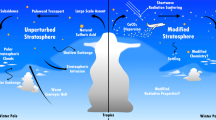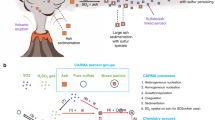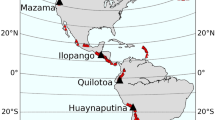Abstract
The deliberate injection of particles into the stratosphere has been suggested as a possible geoengineering scheme to mitigate the global warming aspect of climate change. Injected particles scatter solar radiation back to space and thus reduce the radiative balance of Earth. Previous studies investigating this scheme have focused primarily on sulphuric acid particles to mimic volcanic injections of stratospheric aerosol. However, the composition and size of volcanic sulphuric acid particles are far from optimal for scattering solar radiation. We show that aerosols with other compositions, such as minerals, could be used to dramatically increase the amount of light scatter achieved on a per mass basis, thereby reducing the particle mass required for injection. The chemical consequences of injecting such particles into the stratosphere are discussed with regard to the fate of the ozone layer. Research questions are identified with which to assess the feasibility of such geoengineering schemes.
This is a preview of subscription content, access via your institution
Access options
Subscribe to this journal
Receive 12 print issues and online access
$209.00 per year
only $17.42 per issue
Buy this article
- Purchase on Springer Link
- Instant access to full article PDF
Prices may be subject to local taxes which are calculated during checkout



Similar content being viewed by others
References
Shepherd, J. Geoengineering the Climate: Science, Governance and Uncertainty (The Royal Society, 2009).
Keith, D. W. Geoengineering. Nature 409, 420–420 (2001).
Eatough, D. J., Caka, F. M. & Farber, R. J. The conversion of SO2 to sulfate in the atmosphere. Isr. J. Chem. 34, 301–314 (1994).
Solomon, S. et al. The persistently variable 'background' stratospheric aerosol layer and global climate change. Science 333, 866–870 (2011).
Murphy, D. M., Thomson, D. S. & Mahoney, M. J. In situ measurements of organics, meteoritic material, mercury, and other elements in aerosols at 5 to 19 kilometers. Science 282, 1664–1669 (1998).
Hansen, J., Lacis, A., Ruedy, R. & Sato, M. Potential climate impact of Mount Pinatubo eruption. Geophys. Res. Lett. 19, 215–218 (1992).
Soden, B. J., Wetherald, R. T., Stenchikov, G. L. & Robock, A. Global cooling after the eruption of Mount Pinatubo: A test of climate feedback by water vapor. Science 296, 727–730 (2002).
Minnis, P. et al. Radiative climate forcing by the Mount Pinatubo eruption. Science 259, 1411–1415 (1993).
McCormick, M. P., Thomason, L. W. & Trepte, C. R. Atmospheric effects of the Mt Pinatubo eruption. Nature 373, 399–404 (1995).
Crutzen, P. Albedo enhancement by stratospheric sulfur injections: A contribution to resolve a policy dilemma? Climatic Change 77, 211–220 (2006).
Rasch, P. J. et al. An overview of geoengineering of climate using stratospheric sulphate aerosols. Phil. Trans. R. Soc. A 366, 4007–4037 (2008).
Rasch, P. J., Crutzen, P. J. & Coleman, D. B. Exploring the geoengineering of climate using stratospheric sulfate aerosols: The role of particle size. Geophys. Res. Lett. 35, L02809 (2008).
Blackstock, J. J. et al. Climate Engineering Responses to Climate Emergencies (Novim, 2009); available at http://arxiv.org/pdf/0907.5140.
Katz, J. I. Stratospheric albedo modification. Energ. Environ. Sci. 3, 1634–1644 (2010).
Davidson, P., Hunt, H. E. M. & Burgoyne, C. J. Atmospheric delivery system. UK patent application GB2476518 (2009).
Keith, D. W. Photophoretic levitation of engineered aerosols for geoengineering. Proc. Natl Acad. Sci. USA 107, 16428–16431 (2010).
Ferraro, A. J., Highwood, E. J. & Charlton-Perez, A. J. Stratospheric heating by potential geoengineering aerosols. Geophys. Res. Lett. 38, L24706 (2011).
Andrews, D. G., Leovy, C. B. & Holton, J. R. Middle Atmosphere Dynamics (Academic, 1987).
Niemeier, U., Schmidt, H. & Timmreck, C. The dependency of geoengineered sulfate aerosol on the emission strategy. Atmos. Sci. Lett. 12, 189–194 (2011).
Davidson, P., Burgoyne, C., Hunt, H., Loew, D. & Causier, M. Lifting options for stratospheric aerosols: Enabling geoengineering by solar radiation management. Proc. R. Soc. A http://dx.doi.org/10.1098/rsta.2011.0639 (in the press).
McClellan, J., Sisco, J., Suarez, B. & Keogh, G. Geoengineering Cost Analysis (Aurora Flight Sciences Corporation, 2010).
Robock, A., Marquardt, A., Kravitz, B. & Stenchikov, G. Benefits, risks, and costs of stratospheric geoengineering. Geophys. Res. Lett. 36, L19703 (2009).
World Meteorological Organization — Global Ozone Research and Monitoring Project, Report No. 52 Scientific Assessment of Ozone Depletion: 2010 (2011).
Parker, S. P. McGraw-Hill Concise Encylopaedia of Science and Technology (McGraw-Hill, 1982).
Pallé, E. et al. Earthshine and the Earth's albedo: 2. Observations and simulations over 3 years. J. Geophys. Res. 108, 4710 (2003).
Molina, M. J., Molina, L. T. & Kolb, C. E. Gas-phase and heterogeneous chemical kinetics of the troposphere and stratosphere. Annu. Rev. Phys. Chem. 47, 327–367 (1996).
Solomon, S. Stratospheric ozone depletion: A review of concepts and history. Rev. Geophys. 37, 275–316 (1999).
Solomon, S. et al. The role of aerosol variations in anthropogenic ozone depletion at northern midlatitudes. J. Geophys. Res. 101, 6713–6727 (1996).
Rinsland, C. P. et al. Heterogeneous conversion of N2O5 to HNO3 in the post-Mount Pinatubo eruption stratosphere. J. Geophys. Res. 99, 8213–8219 (1994).
Sander, S. P. et al. Chemical Kinetics and Photochemical Data for Use in Atmospheric Studies (Jet Propulsion Laboratory, 2011).
Davidovits, P., Kolb, C. E., Williams, L. R., Jayne, J. T. & Worsnop, D. R. Update 1 of: Mass accommodation and chemical reactions at gas−liquid interfaces. Chem. Rev. 111, PR76–PR109 (2011).
Kolb, C. E. et al. An overview of current issues in the uptake of atmospheric trace gases by aerosols and clouds. Atmos. Chem. Phys. Discuss. 10, 11139–11250 (2010).
Crowley, J. N. et al. Evaluated kinetic and photochemical data for atmospheric chemistry: Volume V — heterogeneous reactions on solid substrates. Atmos. Chem. Phys. 10, 9059–9223 (2010).
Heckendorn, P. et al. The impact of geoengineering aerosols on stratospheric temperature and ozone. Environ. Res. Lett. 4, 045108 (2009).
Russell, P. B. et al. Global to microscale evolution of the Pinatubo volcanic aerosol derived from diverse measurements and analyses. J. Geophys. Res. 101, 18745–18763 (1996).
Grainger, R. G., Lambert, A., Rodgers, C. D., Taylor, F. W. & Deshler, T. Stratospheric aerosol effective radius, surface area and volume estimated from infrared measurements. J. Geophys. Res. 100, 16507–16518 (1995).
Russell, P. B. et al. Pinatubo and pre-Pinatubo optical-depth spectra: Mauna Loa measurements, comparisons, inferred particle size distributions, radiative effects, and relationship to LiDAR data. J. Geophys. Res. 98, 22969–22985 (1993).
Deshler, T., Liley, J. B., Bodeker, G., Matthews, W. A. & Hoffmann, D. J. Stratospheric aerosol following Pinatubo, comparison of the north and south mid latitudes using in situ measurements. Adv. Space Res. 20, 2089–2095 (1997).
Grainger, R. G. Infrared absorption by volcanic stratospheric aerosols observed by ISAMS. Geophys. Res. Lett. 20, 1283–1286 (1993).
Lambert, A. et al. Measurements of the evolution of the Mt. Pinatubo aerosol cloud by ISAMS. Geophys. Res. Lett. 20, 1287–1290 (1993).
Guo, S., Bluth, G. J. S., Rose, W. I., Watson, I. M. & Prata, A. J. Re-evaluation of SO2 release of the 15 June 1991 Pinatubo eruption using ultraviolet and infrared satellite sensors. Geochem. Geophys. Geosyst. 5, Q04001 (2004).
Fischer, A. M. et al. Interannual-to-decadal variability of the stratosphere during the 20th century: Ensemble simulations with a chemistry-climate model. Atmos. Chem. Phys. 8, 7755–7777 (2008).
Telford, P., Braesicke, P., Morgenstern, O. & Pyle, J. Reassessment of causes of ozone column variability following the eruption of Mount Pinatubo using a nudged CCM. Atmos. Chem. Phys. 9, 4251–4260 (2009).
Hanson, D. R. & Ravishankara, A. R. Reactive uptake of ClONO2 onto sulfuric acid due to reaction with HCl and H2O. J. Phys. Chem. 98, 5728–5735 (1994).
Molina, M. J., Molina, L. T., Zhang, R., Meads, R. F. & Spencer, D. D. The reaction of ClONO2 with HCl on aluminum oxide. Geophys. Res. Lett. 24, 1619–1622 (1997).
World Meteorological Organization — Global Ozone Research and Monitoring Project, Report No. 44 Scientific Assessment of Ozone Depletion: 1998 (1999).
Linsebigler, A. L., Lu, G. & Yates, J. T. Photocatalysis on TiO2 surfaces: Principles, mechanisms, and selected results. Chem. Rev. 95, 735–758 (1995).
Robock, A., Bunzl, M., Kravitz, B. & Stenchikov, G. L. A Test for Geoengineering? Science 327, 530–531 (2010).
Stern, N. The Economics of Climate Change: The Stern Review (Cambridge Univ. Press, 2007).
Liou, K-N. An Introduction to Atmospheric Radiation (Academic, 1980).
Van de Hulst, H. C. Light Scattering by Small Particles (Wiley, 1957).
Boucher, O. On aerosol direct shortwave forcing and the Henyey–Greenstein phase function. J. Atmos. Sci. 55, 128–134 (1998).
Fussen, D., Vanhellemont, F. & Bingen, C. Evolution of stratospheric aerosols in the post-Pinatubo period measured by solar occultation. Atmos. Environ. 35, 5067–5078 (2001).
Hitchman, M. H., McKay, M. & Trepte, C. R. A climatology of stratospheric aerosol. J. Geophys. Res. 99, 20689–20700 (1994).
Dee, D. P. et al. The ERA-Interim reanalysis: Configuration and performance of the data assimilation system. Q. J. R. Meteorol. Soc. 137, 553–597 (2011).
Acknowledgements
The project and the authors F.D.P., P.B., R.G.G., M.K., I.M.W. and R.A.C. were funded by EPSRC grant number EP/I01473X/1. P.J.D. was funded by Davidson Technology Limited.
Author information
Authors and Affiliations
Corresponding authors
Ethics declarations
Competing interests
P.J.D. is employed by Davidson Technology Limited, the company holding the patent application mentioned in ref. 15.
Supplementary information
Supplementary Information
Supplementary Information (PDF 284 kb)
Rights and permissions
About this article
Cite this article
Pope, F., Braesicke, P., Grainger, R. et al. Stratospheric aerosol particles and solar-radiation management. Nature Clim Change 2, 713–719 (2012). https://doi.org/10.1038/nclimate1528
Received:
Accepted:
Published:
Issue Date:
DOI: https://doi.org/10.1038/nclimate1528
This article is cited by
-
Solar Geoengineering, Free-Driving and Conflict: An Experimental Investigation
Environmental and Resource Economics (2024)
-
Sensitivity of tropical monsoon precipitation to the latitude of stratospheric aerosol injections
Climate Dynamics (2022)
-
Uncertainty and the basis for confidence in solar geoengineering research
Nature Reviews Earth & Environment (2020)
-
Experimental reaction rates constrain estimates of ozone response to calcium carbonate geoengineering
Communications Earth & Environment (2020)
-
Mitigation of Arctic permafrost carbon loss through stratospheric aerosol geoengineering
Nature Communications (2020)



